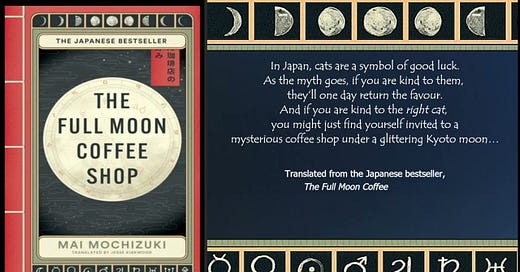🐱 Feline Wisdom and Second Chances: Inside "The Full Moon Coffee Shop"
Dive into a world where dreams and reality blend, guided by mystical cats and cosmic connections.
😽 Keepin’ It Simple Summary for Younger Readers
👧🏾✊🏾👦🏾
🌕 "The Full Moon Coffee Shop" is a magical story about a special café that only appears when the moon is full. 🐱 It's filled with wise cats who help people like Mizuki, a scriptwriter who has lost her inspiration. ✨ She, along with others, finds new hope and friendship in this magical place. 🌟 Through their journeys, they learn about the importance of connecting with their culture and community. 🌍 It’s a tale where the magic of the café shows how much we can learn from each other and the world around us. 🌌
🗝️ Takeaways
🌟 Cosmic Café: The novel centers on a magical café that appears during the full moon, offering a transformative space for its visitors.
🐾 Feline Mentors: Anthropomorphic cats serve as spiritual guides, helping characters navigate personal challenges.
🔄 Second Chances: The story examines who gets the opportunity for renewal and transformation, highlighting societal inequalities.
🌍 Cultural Reconnection: Characters explore and realign with their cultural roots, emphasizing the importance of cultural continuity.
🌱 Communal Bonds: The novel illustrates the power of community and connection in fostering individual growth and collective healing.
🌒 Lunar Inspiration: The narrative structure parallels lunar cycles, drawing on ancient wisdom about human and celestial ties.
Cosmic Connections & Cafecito: A Mathematical Meditation on "The Full Moon Coffee Shop"
By Maextro Morales, Three Sonorans Reviews
¡Saludos, queridos lectores! Welcome to another edition of Three Sonorans Reviews, where we explore literature through the lens of social justice, indigenous wisdom, and, occasionally, mathematical musings.
Today's review comes to you as the Sonoran sun blazes overhead and the Three Sisters in my garden—corn, beans, and squash—dance in the gentle breeze. Their ancient symbiosis is a daily reminder of the interconnectedness of all living things.
The Astronomical Variables: Book & Author Background
Before diving into this novel's gravitational pull, let's establish our celestial coordinates. "The Full Moon Coffee Shop" by Japanese author Mai Mochizuki, translated with remarkable fluidity by Jesse Kirkwood, orbits in the literary galaxy somewhere between Haruki Murakami's dreamscapes and Isabel Allende's magical realism.
Though Mochizuki isn't yet a supermassive black hole in the Western literary universe (absorbing all attention, that is), her work has been steadily gaining luminosity among readers who appreciate stories where the mundane and magical collide like quantum particles—seemingly random yet perfectly choreographed by cosmic forces.
Published originally in Japan before making its way through the wormhole of translation, this novel represents Mochizuki's particular talent for what I call "caffeinated consciousness"—stories that use everyday rituals like coffee drinking as portals to deeper dimensions of understanding.
Much like how Einstein revolutionized physics by contemplating everyday phenomena from extraordinary perspectives, Mochizuki transforms the simple act of visiting a café into an exploration of human transformation.
Plotting the Trajectory: Story Overview
For those who haven't yet had the pleasure of entering Mochizuki's lunar-powered establishment, the novel centers on Mizuki Serikawa, a once-successful scriptwriter whose career has followed what we mathematicians might recognize as a parabolic descent function. After professional setbacks leave her creative energy approaching absolute zero, Mizuki stumbles upon—or perhaps is cosmically guided to—an enchanted coffee shop that materializes only during the full moon.
This supernatural café, operated by a cast of anthropomorphic cats (not to be confused with Schrödinger's thought experiment, though these felines exist in similarly paradoxical states), becomes a liminal space—a quantum field, if you will—where transformation becomes not just possible but inevitable.
The café serves as what topologists might call a "fixed point" in an otherwise chaotic universe, drawing in characters whose life trajectories have become unstable.
The parallel stories of Akari Nakayama (a TV director fighting against the gravitational forces of gender bias) and Takashi Mizumoto (a tech entrepreneur whose success has disconnected him from his cultural roots) intersect with Mizuki's in ways that illustrate how our paths, though seemingly random, form intricate patterns of connection—not unlike the way subatomic particles entangle across vast distances.
The Anthropomorphic Constants: Character Analysis
If we were to plot the characters of "The Full Moon Coffee Shop" on a Cartesian plane, with the x-axis representing external success and the y-axis representing internal fulfillment, we'd see fascinating trajectories:
Mizuki Serikawa: The Protagonist Function
Mizuki begins at what calculus enthusiasts might recognize as a critical point—where the derivative equals zero, and further movement could go in any direction. Her journey from creative paralysis to renewed passion maps beautifully to what we in social justice work recognize as the process of decolonizing one's mind.
Mizuki’s struggle to reclaim her voice parallels how marginalized communities must often rediscover their narratives after systems of oppression have attempted to erase them.
In a world where success is measured by continuous production, the simple act of pausing becomes revolutionary; I thought while watching a hummingbird hover by my roses. Mizuki's transformation reminds us that sometimes, the most productive thing we can do is stop and recalibrate our internal compasses.
The Feline Mentors: Catalytic Converters
The anthropomorphic cats who operate the café—particularly the wise tortoiseshell master—serve as what chemists would call catalysts and what my people would recognize as spiritual guides similar to the animal helpers in Indigenous storytelling traditions. They lower the activation energy required for transformation without being consumed in the process themselves.
When introduced to different human equations, these feline variables produce solutions that might otherwise have remained imaginary numbers in the complex plane of possibility.
Their wisdom comes not from academic credentials (though I'd wager the tortoiseshell master could teach a masterclass in applied psychology) but from their ability to observe humans with both detachment and compassion—a skill many of us in academia could stand to develop.
Quantum Entanglement: Themes & Social Justice Perspective
Reading this novel through my Indigenous Chicano lens reveals several thematic photons worth measuring:
The Probability Distribution of Second Chances
One cannot help but question: Who is afforded the luxury of second chances in our society? Who has access to spaces of healing and transformation? While Mochizuki's magical café offers renewal to all who enter (a beautiful egalitarian model), our real-world institutions operate more like Maxwell's Demon—allowing some particles to pass through while blocking others, creating unequal distributions of energy and opportunity.
The character development throughout the novel shows what mathematicians call monotonically increasing functions—steady, meaningful growth over time. But in our society, structural barriers flatten these functions for many, particularly those from marginalized communities. In this context, Mizuki's journey of reclaiming her creative voice becomes not just personal healing but an act of resistance against systems designed to silence certain voices.
The Conservation of Cultural Energy
Takashi's storyline particularly resonated with me as someone who has witnessed how capitalism's gravitational pull often separates individuals from their cultural orbits.
His reconnection with childhood friend Megumi mirrors the journey many of us from Indigenous backgrounds experience as we work to reconcile our traditional knowledge systems with contemporary reality.
This theme speaks to what I often tell my young activists: colonization attempted to sever our connections not just to land and language but also to cosmic relationships. In our rush to conquer space, we've forgotten how to converse with it.
Lunar Cycles and Human Algorithms: Celestial Connections
The novel's premise—a café appearing only during the full moon—taps into knowledge systems far older than Silicon Valley algorithms or even Newtonian physics. While modern astronomers map exoplanets and quantify cosmic radiation with impressive precision (no shade to NASA—their work is literally stellar), our ancestors understood something equally valuable: the rhythmic dance between heavenly bodies and human experience.
What strikes me most profoundly about Mochizuki's narrative structure is how it follows lunar phases: Mizuki's despair during the dark moon, her discovery during the waxing period, and her creative rebirth at fullness. This isn't a mere literary device but a recognition of patterns our ancestors observed through millennia of careful attention.
In my Three Sisters Garden, I follow planting calendars developed by Indigenous communities who tracked lunar cycles not as distant astronomical phenomena but as living guides for agricultural and spiritual practice. This isn't superstition (a term often used to dismiss Indigenous knowledge systems with the same casual disregard flat-earthers show for satellite imagery) but generational empiricism—observation passed through centuries of careful attention.
The cats in Mochizuki's story serve as what my people might call "star keepers"—beings who understand celestial rhythms and help others align with them. Their wisdom challenges the artificial boundary Western science has erected between the observer and the observed, suggesting instead that we exist in a continuous relationship with cosmic forces.
The Mathematics of Magic: Community & Connection
At its core, "The Full Moon Coffee Shop" solves what I call the fundamental equation of modern alienation: how do we reconnect with ourselves and others in a world that increasingly functions like isolated variables rather than related expressions?
Mochizuki's solution isn't found in technology (no app can replicate the magic of the café, though I'm sure venture capitalists would fund that startup in a heartbeat) but in creating spaces where authentic transformation can occur. The café becomes what topologists call a "neighborhood"—a defined space around a point where certain properties hold true.
Just as my Three Sisters Garden demonstrates the power of complementary growth (corn providing structure, beans fixing nitrogen, squash preventing weeds), Mochizuki's characters show how human connections nurture our individual journeys. This mutual support system creates what ecologists call emergent properties—benefits that arise from relationships and cannot exist in isolation.
Brewing Conclusions: Final Thoughts
As I sip the last of my morning cafecito and watch desert light transform the ocotillo from silhouette to sentinel, I reflect on how stories like "The Full Moon Coffee Shop" remind us that magic exists not in defiance of natural laws but as expressions of relationships we've forgotten how to measure.
For readers craving stories that blend magical realism with meaningful character development, I recommend brewing your own cup of something warming, finding a quiet corner under the desert sky (or your local indoor approximation thereof), and allowing yourself to be transported to Mochizuki's enchanted café.
In a world increasingly defined by disconnection and digital noise, this novel offers a gentle reminder that transformation often happens in spaces of community over shared cups of something warm and nourishing. It honors both modern complexity and ancient wisdom, suggesting that our ancestors—whether Japanese, Indigenous American or any other tradition—were not trying to escape science but were practicing it in ways that honored human experience as part of the data set rather than separate from it.
The full moon has been measuring time, influencing tides, and inspiring humans long before we invented atomic clocks or GPS satellites. Mochizuki's novel suggests that perhaps it still has something to teach us about our own internal rhythms and connections—if only we'd look up from our screens long enough to notice.
¡Hasta la próxima lectura, compañeros cósmicos! Maextro Morales
Post-Script: My Three Sisters send their regards. The corn stands tall like Mizuki's renewed confidence, the beans spiral upward like Akari's ambition, and the squash spreads wide like Takashi's reconnection with his roots. In the garden, as in the cosmos, nothing exists in isolation.





![The Full Moon Coffee Shop [Book Teaser] The Full Moon Coffee Shop [Book Teaser]](https://substackcdn.com/image/fetch/$s_!rsGd!,w_1456,c_limit,f_auto,q_auto:good,fl_progressive:steep/https%3A%2F%2Fsubstack-post-media.s3.amazonaws.com%2Fpublic%2Fimages%2F27804e9f-1de5-4b9c-b544-4fd83e41815c_1280x720.jpeg)

